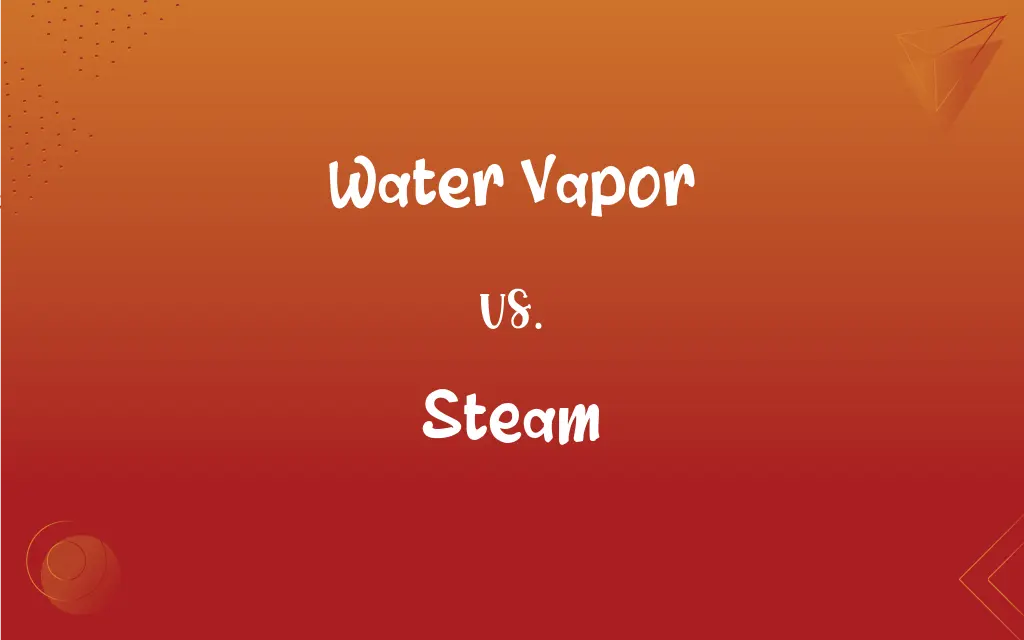Water Vapor vs. Steam: What's the Difference?
Edited by Aimie Carlson || By Harlon Moss || Updated on October 13, 2023
Water vapor is the gaseous form of water; steam is water vapor heated to a temperature where it's visible.

Key Differences
Water vapor and steam both refer to the gaseous state of water, but they have differences in context and perception. Water vapor is an invisible gas present in the atmosphere, while steam is generally associated with the visible mist that results when water is boiled.
Water vapor is omnipresent in the air, to varying degrees, depending on temperature and humidity. It plays a key role in weather patterns and climate. Steam, on the other hand, is often a result of industrial processes or daily activities, like cooking or showering.
It's crucial to recognize that all steam is water vapor, but not all water vapor is steam. Steam is a specific form of water vapor that occurs when water reaches its boiling point and becomes visible. Water vapor, conversely, can be present without any visible manifestation.
Water vapor can be found in the atmosphere at almost any temperature, from the cold of outer space to the warmth of a summer day. Steam, conversely, specifically relates to heated water, commonly seen rising from kettles, radiators, or steam engines.
In discussions of the water cycle, we often reference water vapor as it evaporates from oceans, lakes, and rivers. It's a natural and invisible part of the atmosphere. Steam, while still a natural occurrence, is more often associated with human activity and visible manifestations of heated water vapor.
ADVERTISEMENT
Comparison Chart
State
Invisible gaseous form of water
Visible form of water vapor
Presence
Present in the atmosphere regardless of human intervention
Often results from human activities or natural hot springs
Temperature Requirement
Can exist at a wide range of temperatures
Specifically relates to water at or above boiling point
Association
Often linked with weather patterns and climate
Commonly associated with boiling, cooking, or industrial processes
Visibility
Cannot be seen with the naked eye
Visible as it contains tiny water droplets suspended in the air
ADVERTISEMENT
Water Vapor and Steam Definitions
Water Vapor
Water vapor can be found in the atmosphere at various concentrations.
The relative humidity measures the amount of water vapor in the air.
Steam
Steam is water vapor that contains tiny water droplets.
He opened the lid, and steam fogged up his glasses.
Water Vapor
Water vapor contributes to the greenhouse effect on Earth.
Greenhouse gases, including water vapor, trap heat in the atmosphere.
Steam
Steam is used to power certain engines and machinery.
The old locomotive was powered by steam.
Water Vapor
Water vapor is invisible moisture in the air.
Despite the clear skies, there's a lot of water vapor in the atmosphere.
Steam
Steam is often associated with high temperatures.
Be careful when opening the oven; the steam can burn you.
Water Vapor
Water vapor is a critical component of the Earth's water cycle.
Clouds form when water vapor condenses in the atmosphere.
Steam
Steam is the visible vapor into which water is converted when heated to the boiling point.
When the kettle whistled, she saw steam rising from the spout.
Water Vapor
Water vapor is the gaseous phase of water.
The air is humid, indicating a high amount of water vapor present.
Steam
Steam can be harnessed for various purposes, from cooking to cleaning.
She used steam to remove the wallpaper in the living room.
Steam
Hot water vapor produced especially by boiling liquid water.
Steam
Hot, pressurized water vapor used for heating, cooking, or to provide mechanical power.
FAQs
Is all water vapor considered steam?
No, all steam is water vapor, but not all water vapor is steam.
What is steam?
Steam is the visible form of water vapor, typically seen when water is boiled.
Does water vapor play a role in the weather?
Yes, water vapor plays a significant role in weather patterns and climate.
How is steam commonly produced?
Steam is produced by boiling water or through other forms of heating.
Why don't we see water vapor?
Water vapor is invisible to the naked eye because it's in a gaseous state.
Is there water vapor in space?
Yes, water vapor has been detected in space, but it's much less common than on Earth.
Can we convert steam back into water?
Yes, when steam is cooled, it condenses back into liquid water.
How can I see steam at home?
Boiling water in a kettle or pot will produce visible steam.
What is water vapor?
Water vapor is the gaseous form of water that is invisible to the naked eye.
Can steam be dangerous?
Yes, steam can cause burns due to its high temperature and moisture content.
How do clouds form from water vapor?
Clouds form when water vapor condenses into tiny water droplets in the atmosphere.
How is humidity related to water vapor?
Humidity measures the amount of water vapor present in the air.
Where does the water vapor in the atmosphere come from?
It primarily comes from the evaporation of water from oceans, lakes, and rivers.
Can steam be used for cleaning?
Yes, steam is often used for cleaning due to its ability to sanitize and break down grime.
Where can we find water vapor?
Water vapor is present in the atmosphere, varying based on temperature and humidity.
What is the role of steam in industrial processes?
Steam is often used for power generation, heating, and various other industrial processes.
Why is steam used in saunas?
Steam in saunas helps open pores, increase sweating, and promote relaxation.
Does water vapor exist outside of the Earth's atmosphere?
Yes, water vapor has been detected on other planets and in interstellar space.
Why does steam rise?
Steam rises because it's less dense than the surrounding cooler air.
Does water vapor have an effect on global warming?
Yes, water vapor is a greenhouse gas and contributes to the greenhouse effect.
About Author
Written by
Harlon MossHarlon is a seasoned quality moderator and accomplished content writer for Difference Wiki. An alumnus of the prestigious University of California, he earned his degree in Computer Science. Leveraging his academic background, Harlon brings a meticulous and informed perspective to his work, ensuring content accuracy and excellence.
Edited by
Aimie CarlsonAimie Carlson, holding a master's degree in English literature, is a fervent English language enthusiast. She lends her writing talents to Difference Wiki, a prominent website that specializes in comparisons, offering readers insightful analyses that both captivate and inform.































































